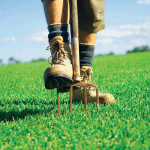 If you have determined that your lawn is suffering from soil compaction then you need to take action. Due to compacted soil having less space to hold the air and water that is needed for optimum lawn health it can lead to a soil which can store less water and where it’s more difficult for lawn plant roots to penetrate. It will also be harder for fertilisers and nutrients to be absorbed into the soil to do their job.
If you have determined that your lawn is suffering from soil compaction then you need to take action. Due to compacted soil having less space to hold the air and water that is needed for optimum lawn health it can lead to a soil which can store less water and where it’s more difficult for lawn plant roots to penetrate. It will also be harder for fertilisers and nutrients to be absorbed into the soil to do their job.
If your lawn has high traffic areas or contains a high proportion of clay then soil compaction is more likely to occur. In order to determine whether or not your lawn is suffering from compaction all you need to do is to push a garden fork into the soil and if you struggle to get the fork in at least halfway up the tines then you have a compaction problem. With soil compaction the lawn plants will be unable to penetrate deeply into the soil. This issue needs to be treated to stop lawn plants from growing along the top of the lawn which can lead to thatching.
To treat a compacted lawn you must aerate the soil. Just like aerating puts bubbles of air into your soft-drink, aerating your lawn is quite simply supplying the soil with air. Aerating will cause there to be larger spaces in the soil and allow more oxygen, fertiliser, nutrients and water to penetrate.
This best time to undertake aeration is at the beginning of the growing season as the weather begins to warm up. The day before you plan to aerate it is advisable to water the lawn thoroughly; this will make the entire process easier and more effective.
For a smaller area of lawn
A smaller area of lawn can be aerated manually with aerating sandals (sandals with spikes attached to the bottom that aerate the lawn as you walk) or a sturdy garden fork. Simply insert the fork into the lawn and punch holes into the turf. Aim for a spacing between the holes of around 8 – 10 cms. In order to achieve adequate aeration you may need to go over the area twice in a different direction each time.
For a larger area of lawn
To treat soil compaction over a large area it is advisable that you hire a petrol-powered core aerator. Ask for usage instructions from the hire company and read the user manual before commencing. Remember to adhere to all safe operating procedures. A core aerator works by removing small cores of grass and soil from the lawn creating the required spaces in the soil. Prior to using a core aerator mark or flag any irrigation systems and hidden objects in the lawn, such as drains, to be able to easily avoid them. When using a core aerator only go over the lawn once. With this process you will be left with the small cores on the lawn which you can rake up and add to the compost bin if you like, however if left on the lawn they will simple break down over two to four weeks.
Annual aeration is recommended to avoid soil compaction although in very high traffic areas such as where cars are parked or the track to the clothesline may require more frequent attention to ensure your lawn plants are getting all the nutrients, water and oxygen they need to be healthy. Aerating more frequently on sloping areas of your lawn will also be beneficial; it will allow water to be absorbed into the soil which would otherwise run off.
After treating the soil compaction is an ideal time to fertilise your lawn to provide with your soil has been lacking by being compacted.
Tip: It is not recommended to aerate a lawn within the first 12 months of it being sown or laid.



